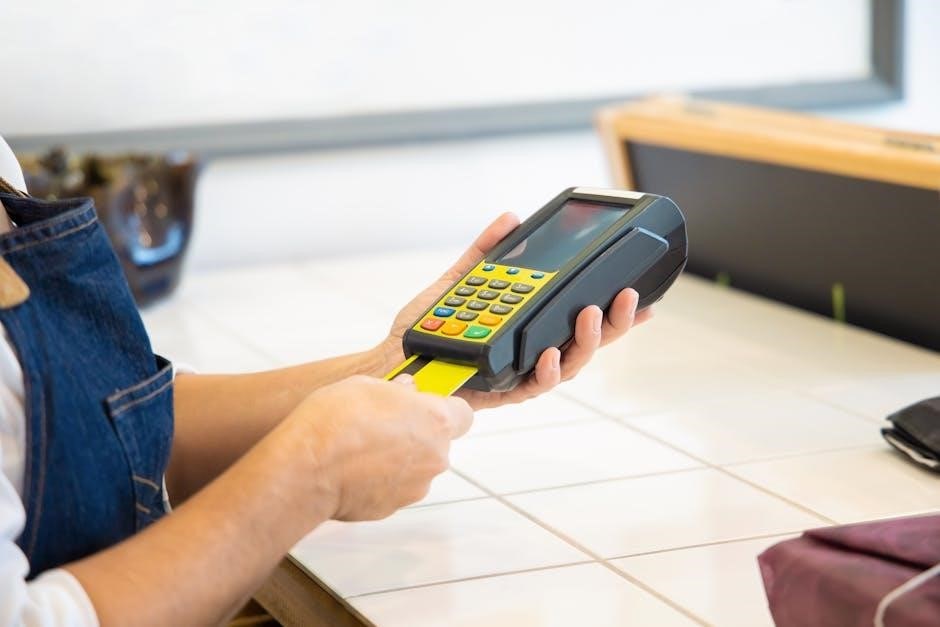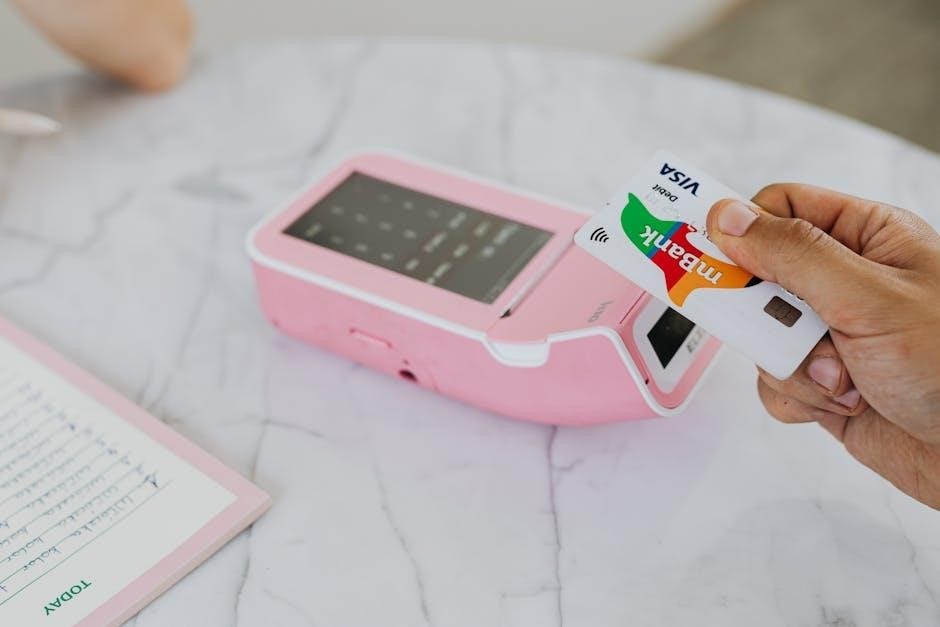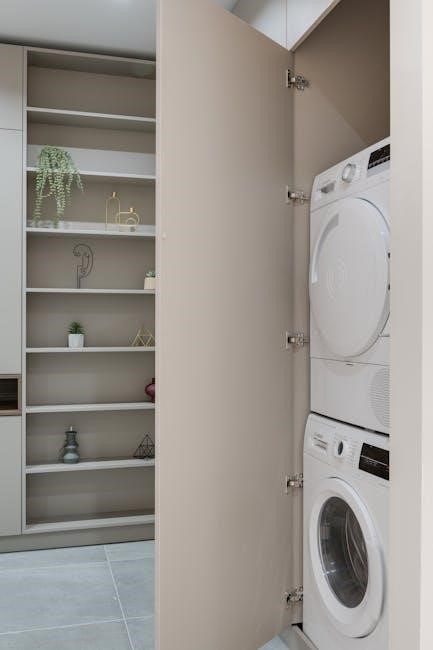The FD150 Credit Card Terminal is a robust point-of-sale device designed for small to medium-sized businesses, enabling seamless transactions with credit, debit, and charge cards. It offers user-friendly functionality, enhanced security, and reliable performance, making it an ideal solution for businesses seeking efficient payment processing. The terminal supports various payment methods, including swipe, insert, and contactless options, ensuring versatility for diverse customer preferences. With its intuitive interface and comprehensive manual, the FD150 simplifies setup and daily operations, providing a hassle-free experience for merchants.
1.1 Overview of the FD150 Terminal
The FD150 Terminal is a versatile and compact point-of-sale solution designed to streamline payment processing for businesses. It supports credit, debit, and charge card transactions, offering a user-friendly interface for seamless operations. The terminal is ideal for small to medium-sized businesses due to its robust design and ease of use. With features like contactless payment capability, EMV chip card compatibility, and fast processing, the FD150 ensures secure and efficient transactions. Its intuitive controls and clear display make it easy for merchants to navigate and perform daily tasks, while the comprehensive manual provides detailed guidance for setup and troubleshooting.
1.2 Importance of the FD150 Terminal Manual
The FD150 Terminal Manual serves as an essential guide for merchants to optimize the terminal’s functionality. It provides step-by-step instructions for setup, configuration, and troubleshooting, ensuring a smooth operational experience. The manual covers critical processes like processing transactions, managing security settings, and maintaining compliance with industry standards. By following the manual, users can resolve common issues, understand payment methods, and ensure their terminal operates efficiently. This comprehensive resource is vital for businesses to maximize the potential of the FD150 Terminal and minimize downtime, making it indispensable for daily operations and long-term success.

Key Features of the FD150 Terminal
The FD150 Terminal supports credit, debit, and charge cards, offering versatile payment options. It features contactless payments, EMV chip compatibility, and a user-friendly interface for seamless transactions.
2.1 Payment Options: Credit, Debit, and Charge Cards
The FD150 Terminal supports a wide range of payment options, including credit, debit, and charge cards. It accepts magnetic stripe cards, EMV chip cards, and contactless payments, ensuring flexibility for customers. The terminal processes sales, refunds, and void transactions seamlessly. For credit cards, it allows balance inquiries, while debit cards support PIN entry for secure transactions. Charge cards are also processed efficiently, making it a versatile solution for various businesses. The terminal’s ability to handle multiple payment types ensures merchants can cater to diverse customer preferences, enhancing the overall payment experience.
2.2 Contactless Payment Capability
The FD150 Terminal features advanced contactless payment technology, enabling quick and secure transactions. Customers can simply tap their contactless card or mobile device near the terminal’s antenna, located around the display and PIN pad, to complete a payment. The terminal indicates successful contactless functionality with a blue light when powered on. This method is fast, convenient, and hygienic, aligning with modern payment preferences. The FD150 supports popular contactless payment methods, making it an ideal solution for businesses looking to offer a seamless and efficient checkout experience.
2.3 EMV Chip Card Compatibility
The FD150 Terminal is fully compatible with EMV chip cards, ensuring enhanced security and compliance with industry standards. For EMV transactions, customers insert their chip card into the slot at the front of the terminal, where the microprocessor chip is read securely. This method reduces the risk of fraud compared to traditional magnetic stripe cards. The terminal processes EMV transactions efficiently, providing a reliable and secure payment option. Businesses can trust the FD150 to handle chip card payments seamlessly, aligning with global payment standards and offering a high level of transaction protection.

Setup and Installation
Setting up the FD150 Terminal involves unboxing, physical placement, and connecting via Ethernet, telephone, or dial-up. A dedicated phone line is recommended for dial-up connections. Installation also includes loading thermal paper for receipt printing, ensuring the terminal is ready for operation.
3.1 Unboxing and Physical Setup
Start by carefully unboxing the FD150 Terminal and verifying all components, including the terminal, power cord, thermal paper roll, and any additional accessories. Place the terminal on a flat, stable surface, ensuring easy access for customers and staff. Connect the power cord securely to both the terminal and a nearby power outlet. Handle the terminal with care to avoid damaging the screen, card reader slot, or PIN pad. Ensure the terminal is positioned upright and stable to prevent accidental tipping. Once powered on, the terminal will display initialization screens, indicating it is ready for further setup and configuration.
3.2 Connecting the Terminal (Ethernet, Telephone, or Dial-Up)
To connect the FD150 Terminal, choose from Ethernet, telephone, or dial-up options; For the fastest processing, use an Ethernet connection by plugging the cable into the terminal’s port. For telephone connectivity, insert the provided phone cord into a dedicated line jack. Dial-up connections are also supported but may result in slower transaction processing. Ensure the terminal is properly linked to a power source before establishing communication. Once connected, the terminal will automatically attempt to communicate with the processor. Verify connection status via the terminal’s display or indicator lights. Follow the Quick Setup Guide for detailed instructions to ensure a seamless setup process.
3.3 Installing Thermal Paper
Installing thermal paper in the FD150 Terminal is a straightforward process. Start by lifting the printer cover located on top of the terminal. Next, align the thermal paper roll with the printer compartment, ensuring the paper feeds from the bottom of the roll upward. Gently place the roll into the compartment, making sure it is securely seated. Close the printer cover and allow the terminal to automatically feed the paper through. Once loaded, the terminal will confirm the paper is ready for use. Always use high-quality thermal paper compatible with the FD150 to ensure clear and legible receipts. Test the printer by printing a sample receipt to verify proper installation.

Processing Transactions
The FD150 streamlines transaction processing with support for swipe, insert, and contactless payments. Its user-friendly interface ensures efficient handling of sales, tips, and manual entries securely.
4.1 Initiating a Sale Transaction
To initiate a sale transaction on the FD150 terminal, select the appropriate payment method and enter the sale amount. The terminal will prompt the customer to present their card, either by swiping, inserting, or tapping. For EMV chip cards, insert the card into the slot at the bottom. Contactless payments can be made by tapping the card or phone near the antenna. Once the payment is processed, the terminal will display the transaction status and print a receipt. Ensure all steps are followed to complete the transaction smoothly and securely.
4.2 Handling Different Payment Methods (Swipe, Insert, Tap)
The FD150 terminal supports three primary payment methods: swipe, insert, and tap. For swiping, guide the magnetic stripe through the card reader. Inserting an EMV chip card involves aligning the chip and fully inserting it into the slot. Contactless payments are made by tapping a card or device near the terminal’s antenna. Each method triggers the terminal to process the payment securely. Ensure the card is presented correctly for smooth transactions. The terminal’s intuitive design accommodates all payment preferences, providing a seamless experience for customers.
4.3 Entering Manual Card Information
Manual card entry on the FD150 terminal is a convenient option when the card’s magnetic stripe or EMV chip is unreadable. To initiate, access the manual entry option in the terminal’s menu. Enter the card number, expiration date, and security code using the keypad. Ensure the information is accurate to avoid errors. After entering the details, the terminal will prompt for authorization. Once approved, complete the transaction and provide a receipt. This method is useful for phone or online orders, ensuring seamless payment processing even without a physical card present. Always follow PCI compliance guidelines to secure sensitive data.
4.4 Handling Tips and Gratuity
The FD150 terminal simplifies handling tips and gratuity, making it easy for businesses to manage customer payments. When a transaction is initiated, the terminal prompts for a tip amount, allowing customers to add gratuity directly. Merchants can pre-set tip percentages or enable custom entries for flexibility. Once the tip is entered, the terminal processes the total amount seamlessly. This feature streamlines transactions in service-based industries, reducing manual calculations and errors. The terminal also supports multiple payment methods, ensuring tips are processed efficiently whether the card is swiped, inserted, or tapped. This functionality enhances customer satisfaction and operational efficiency for businesses.

Managing Transactions
The FD150 terminal offers efficient tools for managing transactions, including voiding transactions, processing refunds, and handling returns. It also supports batch settlement and end-of-day procedures to streamline operations.
5.1 Voiding Transactions
Voiding transactions on the FD150 terminal allows merchants to cancel unauthorized or erroneous sales before settlement. To void a transaction, select the specific sale from the terminal’s history, confirm the action, and the terminal will process the cancellation. This feature ensures errors or accidental charges are resolved promptly; The terminal will then print a void receipt for record-keeping. Note that voids can only be performed before batch settlement, making it essential to address issues quickly. This functionality helps maintain accurate transaction records and provides a seamless way to correct mistakes, enhancing operational efficiency for businesses.
5.2 Refunds and Returns
Processing refunds and returns on the FD150 terminal is straightforward, allowing merchants to address customer requests efficiently. To initiate a refund, access the terminal’s history, select the specific transaction, and choose the refund option. The terminal will prompt for confirmation and guide you through the process. Refunds can be issued using the original payment method, and the terminal will print a receipt for documentation. Returns are handled similarly, ensuring accurate reversal of charges. This feature helps maintain customer satisfaction and streamlines operational tasks, providing a clear and concise way to manage refunds and returns effectively.
5.3 Batch Settlement and End-of-Day Procedures
Batch settlement and end-of-day procedures on the FD150 terminal ensure smooth transaction processing closure. At the end of each business day, merchants must settle the batch to finalize all transactions. This process involves the terminal communicating with the payment processor to submit completed transactions for settlement. The FD150 guides users through this procedure, prompting for confirmation before completing the batch. Once settled, the terminal prints a summary report detailing the day’s transactions. This step is crucial for reconciling payments and preparing for the next business day. The process is secure, efficient, and straightforward, ensuring accurate financial records and compliance with payment standards.

Troubleshooting Common Issues
The FD150 terminal may encounter issues like card reader malfunctions or communication errors. Regularly cleaning the card reader and ensuring stable internet or phone connections can resolve these problems. Additionally, paper jams can be fixed by carefully removing jammed paper and reloading the roll properly. For persistent issues, resetting the terminal or referring to the troubleshooting section in the manual can provide detailed solutions to restore functionality quickly and efficiently.
6.1 Resolving Card Reader Problems
Card reader issues on the FD150 terminal can often be resolved by cleaning the reader slot with a soft cloth or compressed air to remove debris. Ensure the terminal is powered on and the blue light around the PIN pad is active, indicating the reader is functioning. If problems persist, restart the terminal or check for software updates. For chip card issues, verify the card is inserted correctly with the chip facing down. Contactless payments may require repositioning the card near the antenna. Refer to the manual for detailed troubleshooting steps to restore card reading functionality quickly and efficiently.
6.2 Addressing Communication Errors
Communication errors with the FD150 terminal can occur due to connectivity issues. Ensure the terminal is properly connected via Ethernet, telephone, or dial-up. Check all cables for damage or loose connections. Restart the terminal and router to reset the connection. If using dial-up, verify the phone line is dedicated and free from interference. Test the connection by processing a test transaction. If issues persist, ensure the terminal’s software is up to date. Contact your service provider for further assistance if the problem remains unresolved. Regular checks and updates help maintain stable communication and prevent transaction disruptions.
6;3 Solving Paper Jam Issues
A paper jam in the FD150 terminal can disrupt operations. To resolve this, power off the terminal and carefully remove the jammed paper from the thermal printer. Ensure the paper roll is properly aligned and seated before turning the terminal back on. If the issue persists, clean the printer head and surrounding area to remove any debris. Avoid forcing the paper, as this may cause further damage. After clearing the jam, test the printer by printing a test receipt to ensure proper functionality. Regular maintenance, such as checking paper alignment and cleaning, helps prevent future jams and ensures smooth transaction processing.

Security and Compliance

The FD150 terminal ensures secure transactions by meeting PCI compliance standards, protecting customer data through encryption, and supporting EMV chip technology for enhanced fraud prevention and reliable processing.
7.1 Understanding PCI Compliance
PCI compliance ensures the FD150 terminal securely processes card data, adhering to industry standards. It requires encryption of sensitive information, secure storage, and regular software updates to maintain security. Merchants must follow best practices, such as restricting access and monitoring for vulnerabilities, to protect customer data and prevent breaches. The terminal supports these requirements through built-in security features, ensuring transactions are safe and compliant with regulations. By meeting PCI standards, the FD150 helps businesses avoid potential penalties and build trust with customers by safeguarding their financial information effectively.
7.2 Protecting Customer Data
Protecting customer data is critical for maintaining trust and ensuring compliance with security standards. The FD150 terminal employs advanced security measures, such as encryption and tokenization, to safeguard sensitive cardholder information. Merchants should ensure that only authorized personnel have access to the terminal and that strong passwords are used. Regularly updating terminal software and monitoring for suspicious activity can help prevent data breaches. The terminal’s EMV chip compatibility further enhances security by reducing the risk of counterfeit card fraud. By following best practices and leveraging the terminal’s built-in security features, businesses can effectively protect customer data and prevent unauthorized access. This ensures a secure payment environment for all transactions.
7.3 EMV Compliance and Tokenization
The FD150 terminal is fully compliant with EMV standards, ensuring secure transactions and reducing the risk of counterfeit card fraud. By supporting EMV chip cards, the terminal verifies card authenticity through advanced encryption, providing an additional layer of security. Tokenization further enhances data protection by replacing sensitive card information with unique tokens, making it unusable for fraudsters even if intercepted. This combination of EMV compliance and tokenization ensures that customer data remains secure throughout the transaction process, aligning with industry security standards and protecting both businesses and their customers from potential breaches. This dual-layered security approach is essential for modern payment systems.

Maintenance and Care
Regularly clean the terminal with a soft cloth and avoid harsh chemicals to maintain functionality. Replace thermal paper rolls as needed and update software periodically for optimal performance and security.
8.1 Cleaning the Terminal
To maintain the FD150 Terminal’s performance, clean it regularly with a soft, dry cloth. For stubborn spots, lightly dampen the cloth with water, but avoid harsh chemicals or abrasive materials. Gently wipe the keypad, display, and card reader to remove dirt or residue. Ensure the card reader slot is free from debris to prevent processing issues. Avoid exposing the terminal to excessive moisture or direct sunlight. Regular cleaning ensures optimal functionality, extends lifespan, and maintains hygienic conditions for customer interactions. Refer to the manual for detailed cleaning instructions to prevent damage to sensitive components.
8.2 Replacing the Thermal Paper Roll
To replace the thermal paper roll on the FD150 Terminal, first, open the paper compartment by lifting the top cover or accessing it from the side, depending on the terminal’s design. Remove the empty roll and discard it. Take the new thermal paper roll, ensuring it is compatible with the FD150. Insert the roll into the compartment, aligning it with the guides. Gently push it into place until it clicks. Close the compartment and test the terminal by printing a test receipt to ensure proper alignment and functionality. Always refer to the manual for specific instructions to avoid any issues during replacement.
8.3 Updating Terminal Software
To ensure optimal performance, regularly update the FD150 Terminal software. Connect the terminal to a stable internet connection using Ethernet or another recommended method. Access the update feature through the terminal’s menu, typically found under System Settings or Updates. Select Check for Updates to begin the process. If an update is available, follow the on-screen instructions to download and install it. Do not interrupt the terminal during the update process. Once complete, restart the terminal to apply the changes. Always refer to the manual for detailed steps and ensure the terminal is connected to maintain compliance and functionality.

Additional Features
The FD150 Terminal includes a credit card balance inquiry feature, allowing customers to check their card balances. It also provides a quick reference guide for easy navigation and supports online support resources for troubleshooting and additional assistance, ensuring a seamless user experience.
9.1 Balance Inquiry for Credit Cards
The FD150 terminal offers a convenient balance inquiry feature for credit cards, allowing customers to check their available funds. To access this, navigate to the Other menu, select More, and choose Credit Balance Inquiry. Enter the card information, then press Enter. The terminal will display the current balance. This feature is useful for customers to verify their account status before making a purchase. Ensure all optional fields are filled if required. Once the inquiry is complete, the terminal will print a receipt with the balance details, providing a clear and efficient way to assist customers with their financial checks.
9.2 Using the Quick Reference Guide
The Quick Reference Guide for the FD150 terminal is a handy resource designed to help users navigate common functions and troubleshooting steps efficiently. Available both online and as a downloadable PDF, this guide provides step-by-step instructions for performing tasks such as initiating sales, processing refunds, and handling card errors. It also covers essential operations like balance inquiries and batch settlements. The guide is particularly useful for new users, as it simplifies complex processes and ensures smooth transaction handling. By referencing this guide, merchants can quickly resolve issues and optimize their use of the FD150 terminal, enhancing overall efficiency and customer satisfaction.
9.3 Accessing Online Support Resources
Accessing online support resources for the FD150 terminal is straightforward, with a variety of tools available to assist users. The official First Data website offers downloadable PDF manuals, troubleshooting guides, and quick reference materials. Additionally, users can access online tutorials and FAQs to address common questions. For further assistance, the First Data support portal provides detailed documentation and updates. These resources are designed to help merchants troubleshoot issues, understand terminal functionality, and optimize their payment processing experience. By leveraging these online tools, users can ensure smooth operations and resolve any challenges efficiently, keeping their business running seamlessly.
The FD150 Credit Card Terminal is an efficient, secure, and user-friendly solution for businesses, offering comprehensive payment processing with robust features and reliable performance, supported by a detailed manual for seamless operations.
10.1 Summary of Key Points
The FD150 Credit Card Terminal is a versatile and secure payment solution, supporting credit, debit, and charge card transactions with options for swiping, inserting, or tapping. It features EMV chip compatibility and contactless payment capabilities, ensuring compliance with modern security standards. The terminal is user-friendly, with an intuitive interface and a detailed manual that guides merchants through setup, daily operations, and troubleshooting. Its robust performance, reliability, and comprehensive features make it an ideal choice for small to medium-sized businesses seeking efficient payment processing. Regular maintenance, such as cleaning and updating software, ensures optimal functionality.


